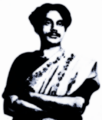Kazi Nazrul Islam
Kazi Nazrul Islam (Bengali: কাজী নজরুল ইসলাম, Bengali pronunciation: [kāzi nôzrul îslām] (![]()
Kazi Nazrul Islam | |
|---|---|
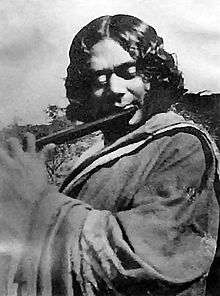 Nazrul in Chattogram, 1926 | |
| Native name | কাজী নজরুল ইসলাম |
| Born | 24 May 1899[1] Churulia village, Asansol, Bengal Presidency, British India (present-day West Bengal, India) |
| Died | 29 August 1976 (aged 77) Dhaka, Bangladesh |
| Resting place | Central Mosque at University of Dhaka |
| Nickname | Bengali: দুখুমিঞা, romanized: Dukhumiyan |
| Occupation |
|
| Language | |
| Nationality | British Empire (1899–1947) Indian (1947–1976) Bangladeshi (1972–1976) |
| Period | 1922–1942 |
| Literary movement | Bengali Renaissance |
| Notable works |
|
| Notable awards |
|
| Spouse | Pramila Devi |
| Children | 4 sons |
| Signature | |
| Military career | |
| Allegiance | |
| Service/ | |
| Years of service | 1917–1920 |
| Rank | Havildar (Sergeant) |
| Unit | 49th Bengal Regiment |
| Battles/wars | First World War |
Born in a Bengali Muslim Kazi family, Nazrul Islam received religious education and as a young man worked as a muezzin at a local mosque. He learned about poetry, drama, and literature while working with the rural theatrical group Letor Dal. He joined the British Indian Army in 1917. After serving in the British Indian Army in the Middle East (Mesopotamian campaign) during World War I,[10] Nazrul established himself as a journalist in Calcutta. He criticised the British Raj and called for revolution through his poetic works, such as "Bidrohi" ("বিদ্রোহী", 'The Rebel') and "Bhangar Gaan" ("ভাঙার গান", 'The Song of Destruction'),[11] as well as in his publication Dhumketu ('The Comet'). His nationalist activism in Indian independence movement led to his frequent imprisonment by the colonial British authorities. While in prison, Nazrul wrote the "Rajbandir Jabanbandi" ("রাজবন্দীর জবানবন্দী", 'Deposition of a Political Prisoner').[12] His writings greatly inspired Bengalis of East Pakistan during the Bangladesh Liberation War.
Nazrul's writings explored themes such as freedom, humanity, love, and revolution. He opposed all forms of bigotry and fundamentalism, including religious, caste-based and gender-based.[13] Nazrul wrote short stories, novels, and essays but is best known for his songs and poems. He profusely enriched ghazals in the Bengali language.[14][15][16] He is also known for his extensive use of Arabic and Persian words in his works.[17][18][19]
Nazrul wrote and composed music for nearly 4,000 songs (many recorded on HMV and gramophone records),[20] collectively known as Nazrul Geeti. In 1942 at the age of 43, he began to suffer from an unknown disease, losing his voice and memory. A medical team in Vienna diagnosed the disease as Pick's disease,[21] a rare incurable neurodegenerative disease. It caused Nazrul's health to decline steadily and forced him to live in isolation in India. He was also admitted in Ranchi (Jharkhand) psychiatric hospital for many years. At the invitation of the Government of Bangladesh, Nazrul's family took him to Bangladesh and moved to Dhaka in 1972.They were awarded citizenship of Ganaprajatantri Bangladesh. He died four years later on 29 August 1976 in Bangladesh.[16]
Early life
 Nazrul at his early age.
Nazrul at his early age.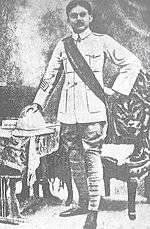 Nazrul in his British Indian Army uniform.
Nazrul in his British Indian Army uniform.
Nazrul was born on Wednesday 24 May 1899[22][23] in the village of Churulia, Asansol Sadar, Paschim Bardhaman district of the Bengal Presidency (now in West Bengal, India). He was born into a Bengali Muslim Taluqdar family and was the second of three sons and a daughter. Nazrul's father Kazi Faqeer Ahmed was the imam and caretaker of the local mosque and mausoleum.[24] Nazrul's mother was Zahida Khatun. Nazrul had two brothers, Kazi Saahibjaan and Kazi Ali Hussain, and a sister, Umme Kulsum. He was nicknamed Dukhu Miañ (দুখু মিঞা literally, 'the one with grief', or 'Mr. Sad Man'). Nazrul studied at a maktab and madrasa, run by a mosque and a dargah respectively, where he studied the Quran, Hadith, Islamic philosophy, and theology. His father died in 1908 and at the age of ten, Nazrul took his father's place as a caretaker of the mosque to support his family. He also assisted teachers in the school. He later worked as the muezzin at the mosque.[1][25]
Attracted to folk theatre, Nazrul joined a leto (travelling theatrical group) run by his uncle Fazle Karim. He worked and travelled with them, learning to act, as well as writing songs and poems for the plays and musicals.[22] Through his work and experiences, Nazrul began studying Bengali and Sanskrit literature, as well as Hindu scriptures such as the Puranas. Nazrul composed folk plays for the group, which included Chāshār Shōng ('the drama of a peasant'), and plays about characters from the Mahabharata including Shokunībōdh ('the Killing of Shakuni), Rājā Judhisthirer Shōng ('the drama of King Yudhishthira), Dātā Kōrno ('the philanthropic Karna'), Ākbōr Bādshāh ('Akbar the emperor'), Kobi Kālidās ('poet Kalidas'), Bidyan Hutum ('the learned owl'), and Rājputrer Shōng ('the prince's sorrow').[1]
In 1910, Nazrul left the troupe and enrolled at the Searsole Raj High School in Raniganj. In school, he was influenced by his teacher, a Jugantar activist, Nibaran Chandra Ghatak, and began a lifelong friendship with fellow author Sailajananda Mukhopadhyay, who was his classmate. He later transferred to the Mathrun High English School, studying under the headmaster and poet Kumudranjan Mallik. Unable to continue paying his school fees, Nazrul left the school and joined a group of kaviyals. Later he took jobs as a cook at Wahid's, a well-known bakery of the region, and at a tea stall in the town of Asansol. In 1914, Nazrul studied in the Darirampur School (now Jatiya Kabi Kazi Nazrul Islam University) in Trishal, Mymensingh District. Amongst other subjects, Nazrul studied Bengali, Sanskrit, Arabic, Persian literature and Hindustani classical music under teachers who were impressed by his dedication and skill.[1][26][27]
Nazrul studied up to grade 10 but did not appear for the matriculation pre-test examination; instead in 1917, he joined the British Indian Army at the age of eighteen. He had two primary motivations for joining the British Indian Army: first, a youthful desire for adventure and, second, an interest in the politics of the time.[28] Attached to the 49th Bengal Regiment, he was posted to the Karachi Cantonment, where he wrote his first prose and poetry. Although he never saw active fighting, he rose in rank from corporal to havildar (sergeant), and served as quartermaster for his battalion.[29]
During this period, Nazrul read extensively the works of Rabindranath Tagore and Sarat Chandra Chattopadhyay, as well as the Persian poets Hafez, Omar Khayyam, and Rumi.[30][31] He learned Persian poetry from the regiment's Punjabi Moulvi, practiced music, and pursued his literary interests. His first prose work, "Life of a Vagabond" ('Baunduler Atmakahini'), was published in May 1919. His poem "Mukti" ("মুক্তি", 'Freedom') was published by the Bengali Muslim Literary Journal (Bangiya Mussalman Sahitya Samiti) in July 1919.[1]
Career
I am the unutterable grief,
I am the trembling first touch of the virgin,
I am the throbbing tenderness of her first stolen kiss.
I am the fleeting glance of the veiled beloved,
I am her constant surreptitious gaze...
I am the burning volcano in the bosom of the earth,
I am the wildfire of the woods,
I am Hell's mad terrific sea of wrath!
I ride on the wings of lightning with joy and profundity,
I scatter misery and fear all around,
I bring earthquakes on this world! "(8th stanza)"
I am the rebel eternal,
I raise my head beyond this world,
High, ever erect and alone!
– Translation by Kabir Choudhary[32]
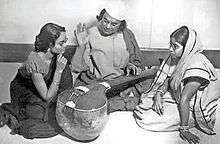
Nazrul left the British Indian army in 1920 when the 49th Bengal Regiment was disbanded.[33] and settled in Calcutta. He joined the staff of the Bangiya Mussalman Sahitya Samiti ("Bengali Muslim Literary Society").[34] He published his first novel Bandhan-hara (বাঁধন-হারা, 'Freedom from Bondage') in 1920, on which he continued to work over the next seven years.[1] His first collection of poems, which included "Bodhan", "Shat-il-Arab", "Kheya-parer Tarani", and "Badal Prater Sharab", received critical acclaim.[1]
Nazrul grew close to other young Muslim writers, while working at the Bengali Muslim Literary Society, including Mohammad Mozammel Haq, Kazi Abdul Wadud, and Muhammad Shahidullah. Nazrul and Muhammad Shahidullah remained close throughout their lives. He was a regular at the social clubs for Calcutta's writers, poets, and intellectuals such as the Gajendar Adda and the Bharatiya Adda. Nazrul did not have the formal education of Rabindranath and as a result his poems did not follow the literary practices established by Rabindranath. Due to this he faced criticism from followers of Rabindranath.[35] Despite their differences, Nazrul looked to Rabindranath Tagore as a mentor.[1] In 1921, Nazrul was engaged to Nargis, the niece of a well-known Muslim publisher, Ali Akbar Khan, in Daulatpur, Comilla.[36] On 18 June 1921, the day of the wedding, upon public insistence by Khan that the term "Nazrul must reside in Daulatpur after marriage" be included in the marriage contract, Nazrul walked away from the wedding ceremony.[37]
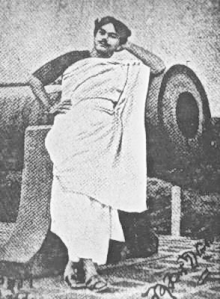
Nazrul reached the peak of his fame in 1922 with Bidrohi (The Rebel), which remains his most famous work, winning the admiration of India's literary society for his description of a rebel.[38] Published in the Bijli (বিজলী, "Lightning") magazine, the rebellious language and theme were well received, coinciding with the Non-Cooperation Movement – the first mass nationalist campaign of civil disobedience against British rule.[1] Nazrul explores the different forces at work in a rebel, the destroyer, and the preserver who is able to express rage as well as beauty and sensitivity. He followed up by writing Pralayollas ('Destructive Euphoria'), and his first anthology of poems, the Agni-veena ("অগ্নি-বীণা", 'Lyre of Fire') in 1922, which enjoyed commercial and critical success. He also published a volume of short stories, the Byathar Dan "ব্যথার দান" ('Gift of Sorrow'),[39] and Yugbani ("যুগবাণী"), an anthology of essays.[40][41]
Nazrul started a bi-weekly magazine, Dhumketu ("ধূমকেতু", 'Comet') on 12 August 1922 that was critical of the British Empire. Earning the moniker of the "rebel poet", Nazrul aroused the suspicion of British Raj authorities.[22][42] The Police raided the office of Dhumketu after it published "Anondomoyeer Agomone" ("আনন্দময়ীর আগমনে"), a political poem, in September 1922. Nazrul was arrested on 23 January 1923 and charged with sedition.[42] He presented a long argument in the court, an excerpt of what he said:
I have been accused of sedition... To plead for me, the king of all kings, the judge of all judges, the eternal truth the living God... I am a poet; I have been sent by God to express the unexpressed, to portray the unportrayed. It is God who is heard through the voice of the poet... I am an instrument of God. The instrument is not unbreakable, but who is there to break God?[43]
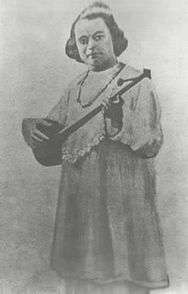
On 14 April 1923, he was moved from Alipore Jail to a jail in Hooghly. He began a 40-day fast to protest mistreatment by the British jail superintendent, breaking his fast more than a month later and eventually being released from prison in December 1923. Nazrul composed numerous poems and songs during his period of imprisonment. In the 1920s, the British Indian government banned many of his writings.[1] Rabindranath Tagore dedicated his play "Basanta" to Nazrul in 1923. Nazrul wrote the poem "Aj Srishti Shukher Ullashe" to thank Tagore.[44] His book Bisher Banshi ('The Flute of Poison'), published in August 1924,[45] was banned by the British Raj.[46] Bisher Banshi called for rebellion in India against the British Raj.[47] Bisher Banshi was read and distributed in secret following the ban.[48]
Nazrul was a critic of the Khilafat Movement in British India which he condemned as "hollow religious fundamentalism".[1] His rebellious expression extended to rigid orthodoxy in the name of religion and politics.[49] He also criticised the Indian National Congress for not embracing outright political independence from the British Empire. Nazrul became active in encouraging people to agitate against British rule, and joined the Bengal state unit of the Indian National Congress.[1] Along with Muzaffar Ahmed, Nazrul also helped organise the Sramik Praja Swaraj Dal (Workers and Peasants Party), a socialist political party committed to national independence and the service of the working class. On 16 December 1925, Nazrul began publishing the Langal ('Plough'), a weekly, and served as its chief editor.[1]
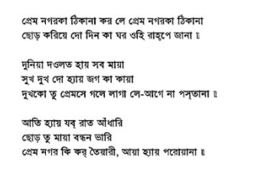
During his visit to Comilla in 1921, Nazrul met a young Bengali Hindu woman, Pramila Devi, with whom he fell in love, and they married on 25 April 1924. Brahmo Samaj criticised Pramila, a member of the Brahmo Samaj, for marrying a Muslim. Muslim religious leaders criticized Nazrul for his marriage to a Hindu woman. He also was criticised for his writings. Despite controversy, Nazrul's popularity and reputation as the "rebel poet" increased significantly.[1][51]
With his wife and young son Bulbul, Nazrul settled in Krishnanagar in 1926. His work began to transform as he wrote poetry and songs that articulated the aspirations of the working class, a sphere of his work known as "mass music".[52]
O poverty, thou hast made me great
Thou hast made me honoured like Christ
With his crown of thorns. Thou hast given me
Courage to reveal all. To thee I owe
My insolent, naked eyes and sharp tongue.
Thy curse has turned my violin to a sword...
O proud saint, thy terrible fire
Has rendered my heaven barren.
O my child, my darling one
I could not give thee even a drop of milk
No right have I to rejoice.
Poverty weeps within my doors forever
As my spouse and my child.
Who will play the flute?
– Translated by Kabir Chowdhury[53]
In what his contemporaries regarded as one of his greatest flairs of creativity, Nazrul vastly contributed in profusely enriching ghazals in Bengali, transforming a form of poetry written mainly in Persian and Urdu.[25] Nazrul's recording of Islamic songs was a commercial success and created interest in gramophone companies about publishing his works. A significant impact of Nazrul's work in Bengal was that it made Bengali Muslims more comfortable with the Bengali arts, which used to be dominated by Bengali Hindus.[54] His Islamic songs are popular during Ramadan in Bangladesh. He also wrote devotional songs on the Hindu Goddess Kali.[55] Nazrul also composed a number of notable Shyamasangeet, Bhajan and Kirtan, combining Hindu devotional music.[56] In 1928, Nazrul began working as a lyricist, composer, and music director for His Master's Voice Gramophone Company.[57] The songs written and music composed by him were broadcast on radio stations across India, including on the Indian Broadcasting Company.[1][58]
I don't see any difference
Between a man and woman
Whatever great or benevolent achievements
That are in this world
Half of that was by woman,
The other half by man.
– Translation by Sajed Kamal[59]
Nazrul believed in the equality of women, a view his contemporaries considered revolutionary, as expressed in his poem Naari (women).[38] Nazrul's poems strongly emphasised the confluence of the roles of both sexes and their equal importance to life. His poem "Barangana" (Prostitute) stunned society with its depiction of prostitutes who he address in the poem as "mother".[60][61] In the poem, Nazrul accepts the prostitute as a human being first, reasoning that this person was breastfed by a noble woman and belonged to the race of "mothers and sisters"; he criticises society's negative views on prostitutes.[62]
An advocate of women rights, Nazrul portrayed both traditional and nontraditional women in his work.[60] He talked about the working poor through his works such as the poem:'Poverty'( Daridro).[32][63]
Nazrul wrote thousands of songs, known collectively as Nazrul Geeti. The exact number is uncertain. The complete text of 2,260 is known, and the first lines of 2,872 have been collected, but according to musicologist Karunamaya Goswami, it is popularly believed that the total is much higher. Goswami has written that some contemporaries put the number near 4,000.[64]
Religious beliefs
Nazrul was a Sunni Muslim. Nazrul wrote an editorial in Joog Bani in 1920 about religious pluralism,
Come brother Hindu! Come Musalman! Come Buddhist! Come Christian! Let us transcend all barriers, let us forsake forever all smallness, all lies, all selfishness and let us call brothers as brothers. We shall quarrel no more.
— [65]
In another article entitled Hindu Mussalman, published in Ganabani on 2 September 1922, he wrote that the religious quarrels were between priests and Imams and not between individual Muslims and Hindus. He wrote that the Prophets had become property like cattle but they should instead be treated like a light that is for all men.[66]
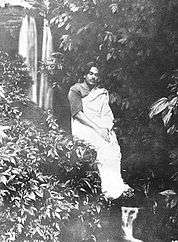
Nazrul criticized religious fanaticism, denouncing it as evil and inherently irreligious. He wrote about human equality in his writings. He also explored the philosophy of the Qur'an and Muhammad by writing about them. Nazrul has been compared to William Butler Yeats by Serajul Islam Choudhury, Bengali literary critic and professor emeritus at the University of Dhaka, for being the first Muslim poet to create imagery and symbolism of Muslim historical figures such as Qasim ibn Hasan, Ali, Umar, Kamal Pasha, and Muhammad.[43] His condemnation of extremism and mistreatment of women provoked condemnation from Muslim and Hindu fundamentalists who opposed his liberal views on religion.[68]
Nazrul's mother died in 1928, and his second son, Bulbul, died of smallpox the following year. His first son, Krishna Mohammad, had died prematurely. Pramila gave birth to two more sons – Sabyasachi in 1928 and Aniruddha in 1931 – but Nazrul remained grief-stricken and aggrieved for a long time. His works changed significantly from the rebellious exploration of society to a deeper examination of religious themes. His works in these years led Islamic devotional songs into the mainstream of Bengali folk music, exploring the Islamic practices of namaz (prayer), roza (fasting), hajj (pilgrimage), and zakat (charity). He wrote the song "O Mon Romzaner Oi Rozar Sheshe" on fasting during Ramadan.[69] This was regarded by his contemporaries as a significant achievement, as Bengali Muslims had been strongly averse to devotional music.[70]
Nazrul was not limited to Islamic devotional music but also wrote Hindu devotional music. He composed Agamanis, Bhajans, Shyama sangeet, and kirtan.[71][72] Nazrul wrote over 500 Hindu devotional songs.[73] Nazrul's poetry and songs explored the philosophy of Islam and Hinduism.[66][74] Nazrul's poetry imbibed the passion and creativity of Shakti, which is identified as the Brahman, the personification of primordial energy. He also composed many songs of invocation to Lord Shiva and the goddesses Lakshmi and Saraswati and on the love of Radha and Krishna.[25] Nazrul was an exponent of humanism.[75] Although a Muslim, he named his sons with both Hindu and Muslim names: Krishna Mohammad, Arindam Khaled (Bulbul), Kazi Sabyasachi and Kazi Aniruddha.[76]
Later life
In 1930, his book Pralayshikhm was banned and he faced charges of sedition by the British Indian colonial government. He was sent to jail and released in 1931, after the Gandhi–Irwin Pact was signed.[46] In 1933, Nazrul published a collection of essays titled "Modern World Literature", in which he analyses different styles and themes of literature. Between 1928 and 1935, he published 10 volumes containing 800 songs, of which more than 600 were based on classical ragas. Almost 100 were folk tunes after kirtans, and some 30 were patriotic songs. From the time of his return to Kolkata until he fell ill in 1941, Nazrul composed more than 2,600 songs, many of which have been lost.[25] His songs based on baul, jhumur, Santhali folksongs, jhanpan, or the folk songs of snake charmers, bhatiali, and bhaoaia consist of tunes of folk-songs on the one hand and a refined lyric with poetic beauty on the other. Nazrul also wrote and published poems for children.[25]
Nazrul's success soon brought him into Indian theatre and the then-nascent film industry.[1] His first film as a director was Dhruva Bhakta, which made him the first Muslim director of a Bengali film.[46] The film Vidyapati (Master of Knowledge) was produced based on his recorded play in 1936, and Nazrul served as the music director for the film adaptation of Tagore's novel Gora. Nazrul wrote songs and directed music for Sachin Sengupta's biographical epic play based on the life of Siraj-ud-Daula.[77] He worked on the plays "Jahangir" and "Annyapurna" by Monilal Gangopadhyay.[77] In 1939 Nazrul began working for Calcutta Radio, supervising the production and broadcasting of the station's musical programs. He produced critical and analytic documentaries on music, such as "Haramoni" and "Navaraga-malika". Nazrul also wrote a large variety of songs inspired by the raga Bhairav.[78]
Illness and death
Nazrul's wife Pramila fell seriously ill in 1939 and was paralysed from the waist down. To provide for his wife's medical treatment, he mortgaged the royalties of his gramophone records and literary works for 400 rupees.[79] He returned to journalism in 1940 by working as chief editor for the daily newspaper Nabayug ('New Age'), founded by the Bengali politician A. K. Fazlul Huq.[79]
On hearing about the death of Rabindranath Tagore on 8 August 1941, a shocked Nazrul composed two poems in Tagore's memory. One of the two poems, "Rabihara" (loss of Rabi, or without Rabi), was broadcast on the All India Radio.[80] Within months, Nazrul himself fell ill and gradually began losing his power of speech. His behaviour became erratic, he started spending recklessly and fell into financial difficulties. In spite of her own illness, his wife constantly cared for her husband. However, Nazrul's health had seriously deteriorated and he grew increasingly depressed. He received treatment under homeopathy as well as Ayurveda, but little progress was achieved before mental dysfunction intensified and he was admitted to a mental asylum in 1942. Spending four months there without making progress, Nazrul and his family began living a quiet life in India. In 1952, he was transferred to a psychiatric hospital in Ranchi. Through the efforts of a large group of admirers who called themselves the "Nazrul Treatment Society",[81] Nazrul and Promila were sent to London, then to Vienna for treatment.[82] The examining doctors said he had received poor care, and Dr. Hans Hoff, a leading neurosurgeon in Vienna, diagnosed that Nazrul was suffering from Pick's disease. His condition was judged to be incurable, Nazrul returned to Calcutta on 15 December 1953.[82] On 30 June 1962 Pramila died,[46] and Nazrul remained in intensive medical care. He stopped working due to his deteriorating health.[83]
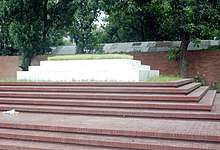
On 24 May 1972, the newly independent nation of Bangladesh brought Nazrul to live in Dhaka with the consent of the Government of India. In January 1976, he was accorded the citizenship of Bangladesh.[1] Despite receiving treatment and attention, Nazrul's physical and mental health did not improve. In 1974. his youngest son, Kazi Aniruddha, a guitarist, died,[85] and Nazrul soon succumbed to his long-standing ailments on 29 August 1976. In accordance with a wish he had expressed in one of his poems, he was buried beside a mosque on the campus of the University of Dhaka. Tens of thousands of people attended his funeral; Bangladesh observed two days of national mourning, and the parliament of India observed a minute of silence in his honour.[86]
Criticism
According to literary critic Serajul Islam Choudhury, Nazrul's poetry is characterised by abundant use of rhetorical devices, which he employed to convey conviction and sensuousness. He often wrote without care for organisation or polish. His works have often been criticized for egotism, but his admirers counter that they carry more a sense of self-confidence than ego. They cite his ability to defy God yet maintain an inner, humble devotion to him.[43] Nazrul's poetry is regarded as rugged but unique in comparison to Tagore's sophisticated style. Nazrul's use of Persian vocabulary was controversial, but it increased the range of his work.[43]
Legacy
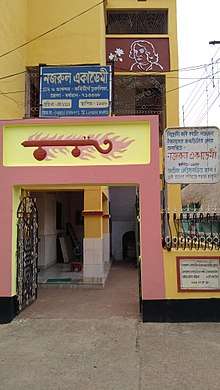
The government of Bangladesh conferred upon him the status of "national poet" in 1972.[87][88] He was awarded an Honorary D.Litt. by the University of Dhaka in 1974 and in 1976 he was awarded the Ekushey Padak by the President of Bangladesh Justice Abu Sadat Muhammad Sayem.[33][46] Many centres of learning and culture in Bangladesh and India had been founded and dedicated to his memory. The Bangladesh Nazrul Sena is a large public organization working for the education of children throughout the country.[89] The Nazrul Endowment provides funding for research into the life and work of Kazi Nazrul Islam in U.S. Universities like California State University, Northridge and Connecticut State University.[90][91] Nazrul was awarded the Jagattarini Gold Medal in 1945 – the highest honour for work in Bengali literature by the University of Calcutta – and awarded the Padma Bhushan, the third-highest civilian award of India, in 1960.[82]
.jpg)
Nazrul's works for children have won acclaim for his use of rich language, imagination, enthusiasm, and an ability to fascinate young readers.[43] Nazrul is regarded for his secularism.[92] His poetry has been translated to languages English, Spanish, and Portuguese.[93] A major avenue is named after him in Dhaka, Bangladesh.[94] Kazi Nazrul University in Asansol, West Bengal, India is named after him.[95] Jatiya Kabi Kazi Nazrul Islam University in Mymensingh, Bangladesh is a public university named after him.[96] Kazi Nazrul Islam Airport in Andal, West Bengal, is India's first private greenfield airport.[7] A chair has been named after him in University of Calcutta and the Government of West Bengal has opened a Nazrul Tirtha in Rajarhat, a cultural centre dedicated to his memory.[7][97] On May 25, 2020, Google celebrated his 121st birthday with a Google Doodle.[98]
Agnibina Express, Dhumketu Express, Dolonchapa Express are the trains of Bangladesh Railway have been named after his literary works.
See also
- List of works of Kazi Nazrul Islam
- Shiulimala, a book of short stories, written by Kazi Nazrul Islam.
References
- Islam, Rafiqul (2012). "Kazi Nazrul Islam". In Islam, Sirajul; Jamal, Ahmed A. (eds.). Banglapedia: National Encyclopedia of Bangladesh (Second ed.). Asiatic Society of Bangladesh. ISBN 978-984-32-0576-6. Retrieved 26 March 2016.
- Langley, Winston (2007). Kazi Nazrul Islam: The Voice of Poetry and the Struggle for Human Wholeness. University of Minnesota. p. 5.
- Talukdar, Rezaul Karim (1994). Nazrul, the gift of the century. Dhaka: Manan. p. 121. ISBN 978-9848156001.
In 1976 Nazrul was awarded the citizenship of Bangladesh.
- Hemal, Mahmudul (28 May 2015). "Nazrul's humanist vision". Dhaka Courier. Archived from the original on 18 April 2017.
- Mitra, Priti K. (1 May 1993). "The Rebel Poet and the Mahatma: Kazi Nazrul Islam's Critique of Gandhi's Politics in the 1920s". South Asia Research. 13 (1): 46–55. doi:10.1177/026272809301300103. ISSN 0262-7280.
- Sheik Hasina; Prime Minister of Bangladesh; transcript of speech. "India-Bangladesh Joint Celebration, 113th birth anniversary of Poet Kazi Nazrul Islam and 90th year of his poem 'Rebel'" (PDF). Prime Minister's Office, Government of the People's Republic of Bangladesh. Retrieved 26 December 2013.
- Chakraborti, Suman (26 May 2015). "West Bengal government celebrates Kazi Nazrul Islam's birth anniversary". The Times of India. Archived from the original on 19 April 2017. Retrieved 6 April 2016.
- "Nazrul Jayanti celebrated across Silchar". The Sentinel. 27 May 2018. Retrieved 28 June 2018.
- Menon, Anoop (26 April 2017). "List of public holidays in May 2017 to plan out your vacations". Travel India. Archived from the original on 28 June 2018. Retrieved 28 June 2018.
Tripura will be celebrating Nazrul Jayanti on 26 May
- "Influence of Nazrul's soldier life on his works". New Age. 26 August 2017. Archived from the original on 4 July 2018. Retrieved 3 July 2018.
- Alam, Abu Yusuf (2005). Muslims and Bengal Politics (1912–24). Raktakarabee. p. 256.
- Hāldār, Gopāl (1973). Kazi Nazrul Islam. Sahitya Akademi. p. 41.
- Kazi, Ankan (14 June 2017). "Diminishing A Poet". The Indian Express. Retrieved 28 June 2018.
- Hussain, Azfar. "Rereading Kazi Nazrul Islam" (Video lecture). Retrieved 15 July 2016.
- Ali, Sarwat (21 September 2014). "A taste of Bengal". The News International. The News on Sunday. Archived from the original on 28 June 2018. Retrieved 28 June 2018.
Firoza Begum too sang these Bengali ghazals of Nazrul Islam
- Islam, Mohammad Shafiqul (25 May 2007). "Nazrul: An ardent lover of humanity". The Daily Star. Archived from the original on 4 February 2018. Retrieved 28 June 2018.
He is best known for his songs, in which he pioneered new forms such as Bengali ghazals
- Shams, Ahmed Tahsin (24 May 2018). "The rebel icon of Bengal: Kazi Nazrul Islam". The Bangladesh Post. Archived from the original on 28 May 2018. Retrieved 7 July 2017.
- Rashid, Md Mumit Al; Nur, Tanjina Binte (24 November 2017). "Persian Words Used in Kazi Nazrul Islam's Poetry". Language Art. 2 (4): 117–128. doi:10.22046/LA.2017.23. ISSN 2538-2713.
- Ahmed, Dr. Forqan Uddin (27 August 2018). "Kazi Nazrul Islam : Classic and romantic". The New Nation. Retrieved 25 May 2020.
- Hossain, Quazi Motahar (2000). "Nazrul Islam, the Singer and Writer of Songs". In Mohammad Nurul Huda (ed.). Nazrul: An Evaluation. Dhaka: Nazrul Institute. p. 55. ISBN 978-984-555-167-0.
- Farooq, Mohammad Omar. "Kazi Nazrul Islam: Illness and Treatment". nazrul.org. Archived from the original on 29 May 2015. Retrieved 26 March 2016.
- "Kazi Nazrul Islam: A Chronology of life". Nazrul Institute, Ministry of Cultural Affairs, Government of Bangladesh. Archived from the original on 24 April 2008. Retrieved 28 April 2008.
- "Tripura celebrates 116th birth anniversary of Kazi Nazrul Islam". aninews.in. Archived from the original on 3 March 2016. Retrieved 27 February 2016.
- Faber, Roland; Slabodsky, Santiago (15 March 2016). Living Traditions and Universal Conviviality: Prospects and Challenges for Peace in Multireligious Communities. Rowman & Littlefield. p. 16. ISBN 978-1-4985-1336-4.
- Chaudhuri, Dilip (22 September 2006). "Nazrul Islam: The unparalleled lyricist and composer of Bengal". Press Information Bureau, Government of India. Archived from the original on 8 February 1999. Retrieved 22 September 2006.
- "Nazrul's birth anniv today". New Age. 25 May 2018. Retrieved 28 June 2018.
- "Nazrul's 119th birth anniversary today". Prothom Alo. 25 May 2018. Retrieved 28 June 2018.
- Bose, Buddhadeva (2000). "Modern Bengali Poetry and Nazrul Islam". In Mohammad Nurul Huda (ed.). Nazrul: An Evaluation. Dhaka: Nazrul Institute. p. 80. ISBN 978-984-555-167-0.
- Zaman, Niaz (17 December 2014). "Impact on Nazrul". The Daily Star. Archived from the original on 17 April 2017. Retrieved 12 July 2016.
- Rahman, Aziz (27 August 2015). "Nazrul: The rebel and the romantic". The Daily Sun. Archived from the original on 17 April 2017. Retrieved 12 July 2016.
- Islam, Mohammad Shafiqul (25 May 2007). "Nazrul: An ardent lover of humanity". The Daily Star. Archived from the original on 4 February 2018. Retrieved 12 July 2016.
- Kabir, Choudhary. "Rebel". Archived from the original on 26 October 2007. Retrieved 8 July 2006.
- "Nazrul's death anniversary today". The Daily Star. 27 August 2015. Retrieved 5 March 2016.
- Khondkar Sirajul Haque (2012), "Bangiya Mussalman Sahitya Patrika", in Sirajul Islam and Ahmed A. Jamal (ed.), Banglapedia: National Encyclopedia of Bangladesh (Second ed.), Asiatic Society of Bangladesh
- Nag, Sajal (2008). "Story of a Rebel Poet". Economic and Political Weekly (Book Review). 43 (26/27): 84–85. ISSN 0012-9976. JSTOR 40278906.
- Nurul Huda, Muhammad (2001). Nazrul's Aesthetics and Other Aspects. Bangladesh: Nazrul Institute. p. 124. Retrieved 26 March 2016.
- Muzaffar Ahmad (1998). Kazi Nazrul Islam Smritikatha. Kolkata, India: National Book Agency. pp. 66–67.
- Amin, Sonia Nishat (1996). The World of Muslim Women in Colonial Bengal, 1876–1939. BRILL. p. 106. ISBN 978-90-04-10642-0.
- Bose, Sugata (2009). A Hundred Horizons: The Indian Ocean in the Age of Global Empire. Harvard University Press. pp. 299. ISBN 978-0-674-02157-0.
- Talukdar, Rezaul Karim; Islam (Kazi), Nazrul (1994). Nazrul, the gift of the century. Manan. pp. 47–48. ISBN 9789848156001.
- Rajesh, K. Guru. Sarfarosh: A Naadi Exposition of the Lives of Indian Revolutionaries. Notion Press. ISBN 9789352061730. Retrieved 26 March 2016.
- Nawaz, Ali (20 January 2015). "Dhumketu". en.banglapedia.org. Banglapedia. Archived from the original on 4 July 2018. Retrieved 3 July 2018.
- Choudhury, Serajul Islam (1 June 2006). "The Blazing Comet". New Age. Archived from the original on 19 July 2010. Retrieved 22 September 2006.
Nazrul Islam did what no other Muslim poet in modern Bengal had dared to do. He created images and symbols out of the well-known heroes from Muslim history. Thus Tariq and Qasim, Ali and Omar, Hasan and Hussain and even the Prophet himself figure in his poetry as historical beings. He also transformed men like Kamal Pasha and Anwar Pasha into symbols. The method is somewhat similar to the one Yeats employed in his poetry.
- "Kazi Nazrul Islam". The Daily Star. 25 May 2015. Archived from the original on 30 May 2017. Retrieved 27 February 2016.
- (Bangladesh), Bāṃlā Ekāḍemī (1995). Bangla Academy Journal. Bangla Academy. p. 41.
- Chandan, Shahnawaz (30 August 2013). "The Life of a Rebel". The Daily Star. Archived from the original on 3 December 2017. Retrieved 27 March 2016.
- Chaman (1977). "The Voice of Nazr-ul-Islam". Indian Literature. 20 (4): 109–118. ISSN 0019-5804. JSTOR 24158699.
- Sen, Manikuntala (2001). In search of freedom: an unfinished journey. Stree. p. 17. ISBN 978-81-85604-25-1.
Learning by heart the poems of his Agnibina and Bisher Banshi, we hid the books in our breasts and passed them secretly to friends. As far as I remember, Bisher Banshi was banned.
- Rushd, Abu (2000). "Nazrul Islam's 'The Rebel'". In Mohammad Nurul Huda (ed.). Nazrul: An Evaluation. Dhaka: Nazrul Institute. p. 100. ISBN 978-984-555-167-0.
- "নজরুলগীতি - World's largest nazrulgeeti portal". nazrulgeeti.org. Retrieved 29 July 2020.
- Chowdhury, Serajul Islam (2000). "The Blazing Comet". In Mohammad Nurul Huda (ed.). Nazrul: An Evaluation. Dhaka: Nazrul Institute. p. 141. ISBN 978-984-555-167-0.
- Islam, Rafiqul (2000). "Nazrul". In Mohammad Nurul Huda (ed.). Nazrul: An Evaluation. Dhaka: Nazrul Institute. p. 113. ISBN 978-984-555-167-0.
- Kabir Chowdhury (Translator) (8 July 2006). "Poverty". Archived from the original on 10 June 2007. Retrieved 8 July 2006.
- Khan, Zillur R. (1985). "Islam and Bengali Nationalism". Asian Survey. 25 (8): 834–851. doi:10.2307/2644113. ISSN 0004-4687. JSTOR 2644113.
- Kamal, Nashid (11 July 2015). "Nazrul Islam's Islamic songs". The Daily Star. Retrieved 23 July 2015.
- Islam, Rafiqul (2000). "Nazrul". In Mohammad Nurul Huda (ed.). Nazrul: An Evaluation. Dhaka: Nazrul Institute. p. 115. ISBN 978-984-555-167-0.
- Hossen, Iftikhar (25 May 2018). "Spreading the passion and enthusiasm of Kazi Nazrul Islam". The Daily Observer. Retrieved 3 July 2018.
- Field, Garrett (22 March 2017). Modernizing Composition: Sinhala Song, Poetry, and Politics in Twentieth-Century Sri Lanka. Univ of California Press. pp. 101. ISBN 9780520294714.
kazi nazrul islam radio.
- The Daily Star. 24 May 2003
- Huda, Mohammad Nurul (2000). "Nazrul's Personlore". In Mohammad Nurul Huda (ed.). Nazrul: An Evaluation. Dhaka: Nazrul Institute. p. 314. ISBN 978-984-555-167-0.
- Ahsanuzzaman, Ahmed. "No Nora's in Popular Bangla Literature" (PDF). IB Sen society. Archived from the original (PDF) on 3 March 2016. Retrieved 8 July 2006.
- Islam, Kazi Nazrul (2000). "Barangana" ["The Courtesan"]. Rebel and Other Poems. Translated by Chakravarthy, Basudha. New Delhi: Sahitya Akademi. pp. 52–54. ISBN 978-81-260-0607-6.
- Goswami, Jay Guru (1978). Svabhabakabi Gobindadasera jibani o sahitya bicara (in Bengali). Sailasri Laibreri.
- Goswami, Karumamaya (1990). Aspects of Nazrul Songs. Dhaka: Nazrul Institute. pp. 178–179. OCLC 23904256.
- Moniruzzaman, Mohammad (2000). "Interaction of Cultures and Kazi Nazrul Islam". In Mohammad Nurul Huda (ed.). Nazrul: An Evaluation. Dhaka: Nazrul Institute. p. 149. ISBN 978-984-555-167-0.
- Bardhan, Protik (29 May 2014). "Kazi Nazrul Islam: Voice of Bengali Muslims and Secular Nationhood". Prothom Alo. Archived from the original on 4 July 2018. Retrieved 4 July 2018.
- Islam, Rafiqul (24 May 2002). "The Champion of a Modern and Peaceful Islam". The Daily Star. Archived from the original on 26 November 2010. Retrieved 26 March 2016 – via nazrul.org.
- Khan, Salimullah (29 August 2015). "Reading Nazrul Islam after Walter Benjamin". The Daily Star. Archived from the original on 22 October 2017. Retrieved 26 February 2016.
Nazrul Islam, all the same, faced condemnation and stiff resistance from all quarters, Brits, Hindus and Muslims alike.
- "10 key events in Kazi Nazrul's life". The Daily Star. Retrieved 26 February 2016.
- Kamrunnessa Azad. 2001. Dharmiya Chetonay Nazrul. Nazrul Institute, Dhaka. 1999. pp. 173–174
- "Nazrul: unique creator of devotional songs". New Age | The Most Popular Outspoken English Daily in Bangladesh. Retrieved 25 May 2020.
- Islam, Nazrul; Arefin, Md Shamsul (21 November 2017). "Nazrul's Contributions in Equality and Egalitarianism: Twenty First Century Perspective". Rochester, NY. Cite journal requires
|journal=(help) - Roger, L.; Bakewell, J., eds. (2011). "Islam, Kazi Nazrul". Chambers Biographical Dictionary (9th ed.). Chambers Harrap. Retrieved 5 March 2016.
and wrote more than 500 devotional Hindu songs.
- Shafiqul Islam, Mohammad (29 May 2010). ""I belong to the world . . ."". The Daily Star. Archived from the original on 4 July 2018. Retrieved 4 July 2018.
- Moniruzzaman, Mohammad (2000). "Interaction of Cultures and Kazi Nazrul Islam". In Mohammad Nurul Huda (ed.). Nazrul: An Evaluation. Dhaka: Nazrul Institute. pp. 153–54. ISBN 978-984-555-167-0.
- Huda, Mohammad Nurul (2000). "Nazrul's Personlore". In Mohammad Nurul Huda (ed.). Nazrul: An Evaluation. Dhaka: Nazrul Institute. pp. 306–307. ISBN 978-984-555-167-0.
- Mallick, Sadya Afreen (28 August 2015). "Nazrul's tryst with Bengali theatre". The Daily Star. Archived from the original on 4 July 2018. Retrieved 5 March 2016.
- Islam, Rafiqul (2000). "Nazrul Islam". In Mohammad Nurul Huda (ed.). Nazrul: An Evaluation. Dhaka: Nazrul Institute. p. 117. ISBN 978-984-555-167-0.
- Kamal, Sajed (2000). "Kazi Nazrul Islam: A Chronology of Life". In Mohammad Nurul Huda (ed.). Nazrul: An Evaluation. Dhaka: Nazrul Institute. p. 325. ISBN 978-984-555-167-0.
- Huda, Muhammad Nurul (2001). Nazrul's Aesthetics and Other Aspects. Nazrul Institute. p. 129.
- "10 key events in Kazi Nazrul's life". The Daily Star. 27 August 2015. Retrieved 5 February 2016.
- Kamal, Sajed (2000). "Kazi Nazrul Islam: A Chronology of Life". In Mohammad Nurul Huda (ed.). Nazrul: An Evaluation. Dhaka: Nazrul Institute. p. 326. ISBN 978-984-555-167-0.
- HR Channel (10 July 2017), Kazi Nazrul Islam – a documentary 1956–1957, retrieved 29 June 2018 Director: Manmath Roy
- "The grave of National Poet Kazi Nazrul Islam on the Dhaka University Central Mosque premises". The Daily Observer. 28 August 2015. Retrieved 5 March 2016.
- Sen, Saibal (6 January 2012). "Political mud-slinging upsets Kazi Nazrul's family". The Times of India. Archived from the original on 2 April 2017. Retrieved 6 March 2016.
- "References to demise of Heads of foreign States or eminent international personalities". 16 October 2007. Archived from the original on 25 March 2012. Retrieved 13 May 2008.
- Kumar Das, Subrata. "Nazrul . . . in the eyes of Benoykumar". The Daily Star. Retrieved 26 February 2016.
- "Kazi Nazrul Islam: Rebel and Lover". Kazi Nazrul Islam: Rebel and Lover. Archived from the original on 6 July 2017. Retrieved 27 February 2016.
The rebel poet Kazi Nazrul Islam was crowned in 1972 as the national poet of Bangladesh.
- "Bangladesh Nazrul Sena". Archived from the original on 11 January 2010. Retrieved 13 May 2008.
- "Nazrul at CSUN". The Daily Star. Retrieved 27 February 2016.
- "Nazrul on the global stage". The Daily Start. Retrieved 27 February 2016.
- "A unique symbol of secularism, President says of the rebel poet Nazrul's birthday celebrated". Banglanews24.com. 25 May 2011. Archived from the original on 10 November 2013.
- "Nazrul's works translated in Spanish and Portuguese". The Daily Star. 20 February 2016. Archived from the original on 4 July 2017. Retrieved 26 February 2016.
- "Karwan Bazar veg traders rout out Rajuk eviction team". The Daily Star. Retrieved 6 April 2016.
block the nearby Kazi Nazrul Islam Avenue
- "Anuradha Mukherjee appointed as new vice-chancellor of Kazi Nazrul Islam University". The Times of India. 24 November 2012. Archived from the original on 4 February 2018. Retrieved 6 April 2016.
- "Murder of Nazrul univ student sparks protest". The Daily Star. 11 March 2016. Archived from the original on 29 June 2018. Retrieved 6 April 2016.
- "'Nazrul Tirtha', a hub of cultural exchange with Bangladesh". Business Standard. 26 May 2014. Archived from the original on 29 June 2018. Retrieved 6 April 2016.
- "Kazi Nazrul Islam's 121st Birthday". Google. 25 May 2020.
External links
| Wikiquote has quotations related to: Kazi Nazrul Islam |
- Works by or about Kazi Nazrul Islam at Internet Archive
- Works by Nazrul Islam (Kazi) at Google Books
- Kazi Nazrul Islam
- Kazi Nazrul Islam Poem
| Wikimedia Commons has media related to Kazi Nazrul Islam. |
